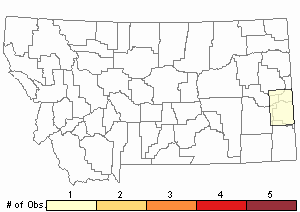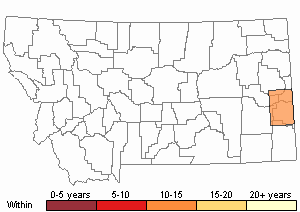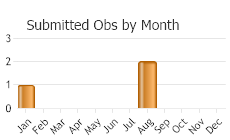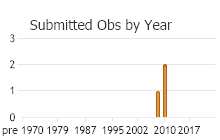View in other NatureServe Network Field Guides
NatureServe
Montana
Utah
Wyoming
Idaho
Wisconsin
British Columbia
South Carolina
Yukon
California
New York
Canada Thistle Stem Gall Fly - Urophora cardui
State Rank Reason (see State Rank above)
Urophora cardui was introduced from Austria and France into Canada and the United States of America (USA) starting in 1977 as a biocontrol agent to control Cirsium arvense, a non-native noxious weed, and to create a balance between a plant species and its natural predator (Winston et al. 2012 and 2016). Urophora cardui was released onto Cirsium arvense plants in nine western states, including Montana. Additional introductions of Urophora cardui into Canada came from Austria, France, and Germany in 1974 and from Finland in 1987. In general, populations are moderately abundant in the USA. A conservation status rank is not applicable (SNA) because Urophora cardui is a non-native insect in Montana that is not a suitable target for conservation activities.
General Description
Canada Thistle Stem Gall Fly (Urophora cardui) is an insect, specifically a type of gall fly in the Family Tephritidae.
ADULTS: Dark bodies. Each wing is white with dark-bands that form a ‘W’ shaped-marking. They grow to 8 mm long. Sources: Winston et al. 2012 and 2016
LARVAE: White, barrel-shaped bodies that have dark brown anal plates. They grow to 5 mm long. Sources: Winston et al. 2012 and 2016
Diagnostic Characteristics
Larvae from different Urophora species can be difficult to distinguish (Winston et al. 2016). The unique characteristic of swollen galls produced by Canada Thistle Stem Gall Fly (Urophora cardui) differentiates it from other thistle-attacking Urophora species.
Range Comments
INTRODUCTION [Adapted from Winston et al. 2012 and 2016]
Established in Canada and the USA on Canada Thistle (Cirsium arvense) plants (Winston et al. 2016). Canada Thistle Stem Gall Fly populations in Canada are more restricted and vary by location and year.
Observations in Montana Natural Heritage Program Database
Number of Observations: 13
(Click on the following maps and charts to see full sized version)
Map Help and Descriptions
Relative Density

Recency



 (Observations spanning multiple months or years are excluded from time charts)
(Observations spanning multiple months or years are excluded from time charts)
Habitat
Populations of Canada Thistle Stem Gall Fly are often restricted to riparian areas. The gall flies do best in moist, sunny to partially shaded areas where the host plant is scattered – especially in places where grass competition is great (Winston et al. 2012 and 2016). In Canada, populations are highest where Canada Thistle is shaded, near water, and in places with mild winter temperatures.
HOST PLANTS
Canada Thistle Stem Gall Fly feeds on Canada Thistle (Winston et al. 2012 and 2016).
Food Habits
Adult weevils feed on basal rosette leaves on Canada Thistle
Larvae feed on plant tissue near the juncture of the stem and root (root crown) on Canada Thistle plants.
Ecology
DAMAGE TO PLANTS [Adapted from Winston et al. 2012 and 2016]
Canada Thistle Stem Gall Fly can reduce the density and stature of Canada Thistle where environmental conditions are favorable.
Larvae feeding causes galls to form. Galls act as metabolic sinks, diverting resources away from normal plant development. Infected plants produce fewer seeds, are more stunted and less competitive, and may be more susceptible to pathogens or other insect species.
ANIMAL-ANIMAL INTERACTIONS
Rodents, birds, and an unknown species of mite prey upon the galls and larvae (Winston et al. 2012 and 2016).
Reproductive Characteristics
LIFE CYCLE [Adapted from Winston et al. 2012 and 2016]
Canada Thistle Stem Gall Fly produces one generation per year. Larvae overwinter inside galls. Pupation occurs in early spring as plant stems bolt. Adults emerge in late spring and early summer when new plants are flowering. Adults deposit eggs on branches near the axillary buds, throughout the summer. Larvae hatch and burrow into stems, causing galls to form. Many larvae live within a single gall. Larvae develop in three stages (instars). Larvae overwinter in the 3rd instar.
Management
BIOLOGICAL CONTROL [Adapted from Winston et al. 2012 and 2016)
A variety of biological control species (insects, fungi, etc.) have been brought into North America to control non-native thistles. A fair amount of preliminary work and an array of factors must be considered when developing a biocontrol plan for controlling non-native thistles. Readers are encouraged to consult the "Useful Links" and cited literature in this profile.
Canada Thistle Stem Gall Fly is a biocontrol insect on Canada Thistle. However, it cannot survive where physical, cultural, and chemical control methods are used on Canada Thistle. Grazing, mowing, chemical treatments, and other practices are not compatible with this biocontrol insect.
Melissa Maggio-Kassner is the coordinator for the Montana Biological Weed Control Project. She can be reached at (406) 258-4223 or
mmaggio@missoulaeduplace.orgUseful Links:Montana Invasive Species websiteMontana Biological Weed Control Coordination Project Field Guide for Biological Control of Weeds in Montana Montana Department of Agriculture - Noxious WeedsMontana Weed Control AssociationMontana Weed Control Association - Weed District ContactsMontana Fish, Wildlife, and Parks - Noxious WeedsMontana State University Integrated Pest Management ExtensionWeed Publications at Montana State University Extension - MontGuides
Stewardship Responsibility
References
- Literature Cited AboveLegend:
 View Online Publication
View Online Publication Winston, Rachel L., Carol Bell Randdall, Rosemarie De Clerck-Floate, Alec McClay, Jennifer Andreas, and Mark Schwarzlander. 2016. Field Guide For The Biological Control of Weeds In The Northwest. August 2016 Reprint. FHTET-2014-08. Forest Health Technology Enterprise Team, University of Idaho Extension and USDA Department of Agriculture.
Winston, Rachel L., Carol Bell Randdall, Rosemarie De Clerck-Floate, Alec McClay, Jennifer Andreas, and Mark Schwarzlander. 2016. Field Guide For The Biological Control of Weeds In The Northwest. August 2016 Reprint. FHTET-2014-08. Forest Health Technology Enterprise Team, University of Idaho Extension and USDA Department of Agriculture. Winston, Rachel, Rich Hansen, mark Schwarzlander, Eric Coombs, Carol Bell Randall, and Rodney Lym. 2012. Biology and Biological Control of Exotic True Thistles. Third Edition, April. FHTET-2007-05. Forest health Technology Enterprise Team, USDA, US Department of Agriculture.
Winston, Rachel, Rich Hansen, mark Schwarzlander, Eric Coombs, Carol Bell Randall, and Rodney Lym. 2012. Biology and Biological Control of Exotic True Thistles. Third Edition, April. FHTET-2007-05. Forest health Technology Enterprise Team, USDA, US Department of Agriculture.
- Additional ReferencesLegend:
 View Online Publication
View Online Publication
Do you know of a citation we're missing? De Smet-Moens, H. 1982. The insect fauna of Canada Thistle Cirsium arvense (L.) Scop in southern Montana. M.Sc. Thesis. Bozeman, MT: Montana State University. 51 p.
De Smet-Moens, H. 1982. The insect fauna of Canada Thistle Cirsium arvense (L.) Scop in southern Montana. M.Sc. Thesis. Bozeman, MT: Montana State University. 51 p.
- Web Search Engines for Articles on "Canada Thistle Stem Gall Fly"
- Additional Sources of Information Related to "Insects"





